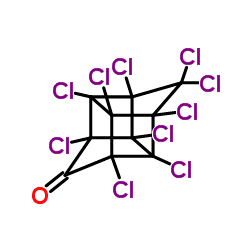Formula C10Cl10O Density 1.6 g/cm³ | Molar mass 490.633 g/mol | |
 | ||
Appearance tan to white crystalline solid | ||
Kepone full album
Kepone, also known as chlordecone, is an organochlorine compound and a colourless solid. This compound is a controversial insecticide related to Mirex and DDT. Its use was so disastrous that it is now prohibited in the western world, but only after many millions of kilograms had been produced. Kepone is a known persistent organic pollutants (POP), classified among the "dirty dozen" and banned globally by the Stockholm Convention on Persistent Organic Pollutants as of 2011.
Contents
- Kepone full album
- Kepone ugly dance full album
- Toxicology
- History
- James River estuary
- French Antilles
- In popular culture
- Synthesis
- References
Kepone ugly dance full album
Toxicology
The LC50 (LC = lethal concentration) is 35 μg/ L for Etroplus maculatus, 0.022–0.095 mg/kg for blue gill and trout. Kepone bioaccumulates in animals by factors up to a million-fold. Workers with repeated exposure suffer severe convulsions resulting from degradation of the synaptic junctions.
Kepone has been found to act as an agonist of the GPER (GPR30).
History
In the US, kepone was produced by Allied Signal Company and LifeSciences Product Company in Hopewell, Virginia. The improper handling and dumping of the substance into the nearby James River (U.S.) in the 1960s and 1970s drew national attention to its toxic effects on humans and wildlife. The product is similar to DDT and is a degradation product of Mirex. The history of Kepone incidents are reviewed in Who's Poisoning America?: Corporate Polluters and Their Victims in the Chemical Age (1982). In 2009, Kepone was included in the Stockholm Convention on persistent organic pollutants, which bans its production and use worldwide.
James River estuary
Due to the pollution risks, many businesses and restaurants along the river suffered economic losses. In 1975 Governor Mills Godwin Jr. shut down the James River to fishing for 100 miles, from Richmond to the Chesapeake Bay. This ban remained in effect for 13 years, until efforts to clean up the river began to get results.
French Antilles
The French island of Martinique is heavily contaminated with kepone, following years of its unrestricted use on banana plantations. Despite a 1990 ban of the substance by France, the economically powerful planter community lobbied intensively to gain the power to continue using kepone until 1993. They had argued that no alternative pesticide was available, which has since been disputed. Similarly, the nearby island of Guadeloupe is also contaminated, but to a lesser extent. Since 2003, local authorities have restricted cultivation of crops because the soil has been seriously contaminated by kepone. Martinique and Guadeloupe have some of the highest prostate cancer diagnosis rates in the world.
In popular culture
Synthesis
Kepone is made by dimerizing hexachlorocyclopentadiene and hydrolyzing to a ketone.
